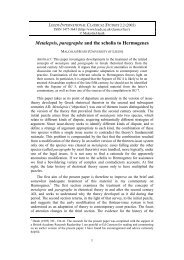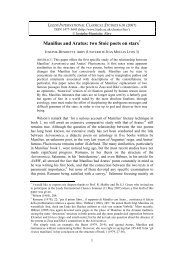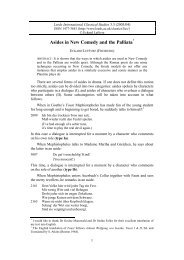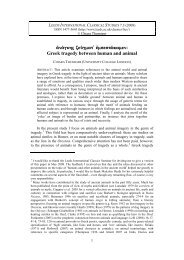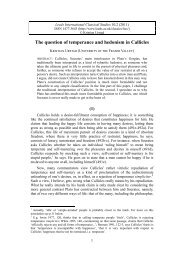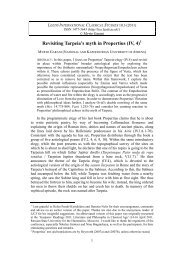The New Posidippus - Leeds International Classical Studies
The New Posidippus - Leeds International Classical Studies
The New Posidippus - Leeds International Classical Studies
You also want an ePaper? Increase the reach of your titles
YUMPU automatically turns print PDFs into web optimized ePapers that Google loves.
MARY FRANCES WILLIAMS, THE NEW POSIDIPPUS<br />
appearance. <strong>Posidippus</strong> instead stresses how the statues appear to be either alive,<br />
full of character, about to speak, or actually speaking. <strong>Posidippus</strong> adheres to<br />
tradition in not describing Myron’s cow (Pos. X.34-37). Yet <strong>Posidippus</strong> is also<br />
innovative since he is not only interested in realism and the sculptors’ skill but<br />
also in the visual impact of the art on the viewer and the artistic theory behind it.<br />
Although the Alexandrian poets occasionally do describe art, ecphrastic<br />
poems are rare and poets are more interested in artifice than realism (for example,<br />
Epicharmus’s statue was ‘in bronze, not in the flesh’). 57 But a few poetic<br />
references to sculpture, painting, and tapestry focus on how lifelike the image is.<br />
In Herondas’ Fourth Mime, two women observe the lifelike beauty of statues and<br />
remark, ‘if it were not stone, the work would speak’, 58 and that one image seems<br />
to be the real woman. 59 One declares that someday men will be able to make<br />
stones be alive. 60 <strong>The</strong> other says Apelles painted the flesh of a boy so that it seems<br />
warm with life. 61 Leonidas of Tarentum says Apelles’ Aphrodite is ‘not painted but<br />
alive’. 62 <strong>The</strong> tapestries in <strong>The</strong>ocritus Idyll 15 appear to be alive. 63 <strong>The</strong>re is also<br />
<strong>The</strong>ocritus’ epigram on a statue of a drunken Anacreon (3440-5 (15) G-P);<br />
Leonidas’ epigram on a statue of Anacreon singing while holding a lyre; 64 and<br />
Jason’s cloak on which Phrixus is depicted as listening to the speaking ram (Ap.<br />
Rhod. 1.763-7). Callimachus describes the size, throne, and footstool of a statue<br />
of Zeus. 65 <strong>The</strong> Greek Anthology includes descriptions of sculpture and painting: 66<br />
<strong>Posidippus</strong> describes Lysipppus’ statue of Kairos; 67 and Nossis mentions an<br />
accurate portrait. 68 But while Zanker proposes that the eye of the Alexandrian<br />
57 <strong>The</strong>oc. Ep. 17.3-4 G-P = AP 9.600: c£lkeÒn nin ¢nt' ¢laqinoà / tˆn ïd' ¢nšqhkan. Cf. Bing<br />
(1988) 119-20, 122.<br />
58 Herond. 4.32-3: e‡ ti m¾ l…qoj, toÜrgon, / re‹j, lal»sei.<br />
59 Herond. 4.37-8: blšyaj / j toàto tÕ e„kÒnisma m¾ tÚmhj de…sqw; cf. 4.27-9, 59-71.<br />
60 Herond. 4.33-4: m©, crÒnwi kot' ênqrwpoi / kºj toÝj l…qouj œxousi t¾n zo¾n qe‹nai. Bing<br />
(1988) 117. Zanker (1987) chs. 2-3; Webster (1964) 156-77.<br />
61 Herond. 4.72-78. Zanker (1987) 43-4. Cf. Körte (1929) 345.<br />
62 Leonidas of Tarentum, AP 16.182 = 2098-106 (23) G-P. Cf. Gelzer (1985) 101.<br />
63 <strong>The</strong>ocr. 15.82-3: æj œtum' ˜st£kanti kaˆ æj œtum' ndineànti, / œmyuc', oÙk nufant£<br />
(‘How true they stand and how true they move about; they’re alive, not woven’); cf. Gow ad loc.<br />
Bing (1988) 117-18; cf. Gelzer (1985) 101.<br />
64 AP 16.306 = 2151-60 (Leonidas 31) G-P; cf. AP 16.307 = 2514-20 (Leonidas 90) G-P. Bing<br />
(1988) 117 & n.2. Webster (1964) 221.<br />
65 Call. Iambus 6 = fr. 196 Pf. Zanker (1987) 64-5 & n.39.<br />
66 Bing (1988) 117-23. Cf. Asclepiades or <strong>Posidippus</strong> on a statue of Cypris (AP 16.68 =<br />
Asclepiades 39 G-P).<br />
67 <strong>The</strong> Kairos stands on top-toe with wings on its feet, holding a razor, with hair over its face and<br />
the back of its head bald (AP 16.275 = 3154-65 (19) G-P). <strong>Posidippus</strong>’ description of the statue<br />
was apparently accurate (Gow and Page (1965) II, 499). Stewart (1990) I, 187-8 believes that<br />
Lysippus’ Kairos allegorically expressed Lysippus’ theory of style and exemplified his symmetria,<br />
rhythmos, and accuracy by combining detail with balance. Lysippus’ Kairos is also evidence of his<br />
interest in allegory (Pollitt (1986) 53-4). Some argue that Lysippus intended his Kairos to express<br />
his artistic theory, perhaps that he dealt with the temporal (‘things as they appeared’) while his<br />
predecessors dealt with timeless things (‘things as they are’) (Pollitt (1986) 54). Cf. Stewart<br />
(1978a). Webster (1964) 58.<br />
68 AP 9.604 = 2815-18 (7) G-P. Cf. Gelzer (1985) 103. Another epigram by Nossis says that<br />
Callo’s portrait was a close likeness (AP 9.605 = 2811-14 (6) G-P).<br />
8



